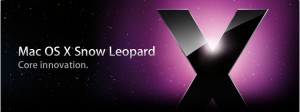Apple wowed its fans and impressed its critics with a successful worldwide developer conference keynote yesterday. Along with much obvious focus on iPhone OS 3.0 and the new speedier iPhone 3GS, the company turned the spotlight on new Mac hardware and the next version of OS X, Snow Leopard. This is a lower-profile OS release than the last two (Tiger and Leopard), as indicated by the lower price ($29) and derivative name. But although there are many few features under the hood, Snow Leopard does little to move the ball forward from a storage perspective. ZFS and iSCSI, two long-rumored features, are notably absent.
Apple first teased both ZFS and iSCSI support back in the Tiger days, and these features were rumored for Leopard but absent on launch. Leopard Server had included read-only ZFS support, but even this level is support is reportedly absent in Snow Leopard. An iSCSI initiator was present in early Leopard builds but never showed up again, even in Snow Leopard. Still, the spread of the iSCSI protocol in the SMB market that has taken to Apple’s server products as well as Microsoft’s successful iSCSI initiator software suggested that an iSCSI initiator might become a Snow Leopard feature, at least in the server version.
Apple’s reduced focus on ZFS is understandable. Although it offers some compelling advantages, especially in server environments, it would bring little to the laptop/desktop market. In fact, ZFS is not really all that useful on the typical end-user Mac, with a single hard disk drive and a raft of removables attached with USB or FireWire. On the other hand, iSCSI support would have been increasingly welcome even in the consumer world as products like Drobo and Iomega add iSCSI as an option. The lack of a built-in initiator marginalizes the Mac in the emerging Ethernet SAN world, leaving vendors like Drobo to go it alone.

I wonder if Oracle’s acquisition of Sun might be responsible for the death of ZFS integration? Perhaps Apple doesn’t want to “own” this is Oracle decides to no longer offer a Open Source/GPL license? I know they can’t take it back, but nothing says they have to support it/enhance it in the future either, not as an open source project anyways. Or maybe the litigation with NetApp scared them off?
Personally I wish that they would do the last 10% of the work to make Disk Manager really great. Offer different RAID types. Automate event notification. Ditto the 10% comment for Time Machine, while we are at it…
I have no idea why Apple is so anti iSCSI. I can see ZFS being pulled because of the NetApp lawsuite and Oracle purchase but iSCSI support can be found in fairly low end QNAP NAS.
I have no idea why Apple is so anti iSCSI. I can see ZFS being pulled because of the NetApp lawsuite and Oracle purchase but iSCSI support can be found in fairly low end QNAP NAS.
Indeed, iSCSI is becoming more important by the day. We know Apple had a working software initiator in Leopard betas a few years back. I wish they would just put some development effort into finalizing that!
Indeed, iSCSI is becoming more important by the day. We know Apple had a working software initiator in Leopard betas a few years back. I wish they would just put some development effort into finalizing that!